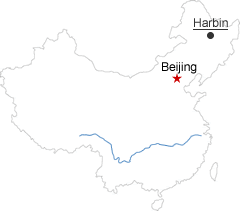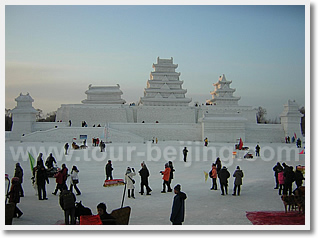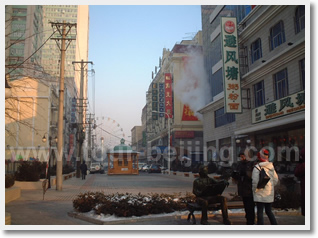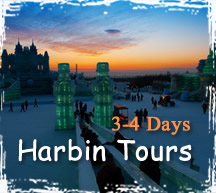Harbin Travel Guide
 Location: situated at the middle reaches of the Songhuajiang River on the Songliao Plain
Location: situated at the middle reaches of the Songhuajiang River on the Songliao Plain
Population: 9,899,000
Area: 331.21 square kilometer
Nationalities: Han, Manchu, Korea,
History: Harbin was a small fishing village on the Songhua River the name means “where the fishing nets are dried” until world history intervened. In 1896 the Russians obtained a contract to build a rail line fromVladivostok through Harbin to Dalian, and the town’s population swelled.
More Russians arrived in 1917, this time White Russian rcihgees fleeing the Bolsheviks, and many stayed on for the rest of their lives. In 1932, the city was briefly captured by the Japanese forces invading Manchuria, then in 1945 it fell again to the Russian army, who hold it for a year befbre Stalin and Chiang Kaishek finally came to an agreement.
The city reverted to the Chinese, though when the Russians withdrew, they took with them most of the city’s industrial plant. Things haven’t been totally peaceful since - Harbin was the scene of fierce factional fighting during the Cultural Revolution, and when relations with the Soviet Union deteriorated, the inhabitants looked anxiously north as fierce border skirnfishes took place.
Not surprisingly, the city used to be nicknamed “Little Moscow”, and though much of the old architecture has been torn down and replaced with sterile blocks and skyscrapers, the place still looks a little like the last thread- bare outpost of imperial Russia. Leafy boulevards are lined with European- style buildings painted pastel shades, and bulbous onion domes dot the sky- line. It’s possible to eat in Russian restaurants, and the locals have picked up on some of their neighbour’s customs: as well as developing a taste for ice cream and pastries.
Climate: Harbin is infamous for its very cold winters — it is at the same latitude as Montreal, and winter temperatures as low as -38.1°C have been recorded. Harbin can be a great place to visit in the summer. The average temperature of hottest August is about 23.2 degree Celsius. The weather is cool and it seems to be perpetually breezy, and most of Harbin's streets are lined with trees. The annual precipitation is around 462mm.
Transportation: Airline-Harbin Taiping International Airport is the second largest international airport in Northeast China. There are airlines leaving for more than 30 medium or large cities such as Beijing, Shanghai, Tianjin and so on. Besides, regular international air services are available between Harbin and foreign cities, such as Blagoveshchensk, and V ladivostok of Russia in Far East, and Seoul in Korea.
Railway- Harbin is the second railway conjunction next only to Shenyang in Northeast China, and the cross of the five railway lines such as Beijing-Harbin, and Harbin-Sufenhe Harbin has two railway stations: Harbin Station and Harbin Eastern Station. Highway- Four national highways lead to all parts of the country: 102 national highway, 202 national highway, 221 national highway, 301 national highway. Waterway-Harbin harbor is one of the eight freshwater harbors and the largest freshwater harbor in the northeast of China. Its courses spread all over Songhua River, Heilong River, Wusuli River and Nen River, and communicated with some ports of Russia, arriving Japan, Korea, Southeast of Asia. Now it has Passenger transport Port and Freight Port.
Local Specialties: Russian Dolls, Northeastern Tirana, Fangzheng Paper-cut, Harbin Knit Embroiders, The handcraft picture of Wheat straw
Local Food: Old Dingfeng Cake, Crisp Pastry, Fried Beijing-style Tripe with Pine Nut, Aired Sausage, Smoked Salmon, Catsup bone, Flying dragon soup, Flying dragon soup, Beiqi Fenggu
 |
 |
Questions & Answers:




